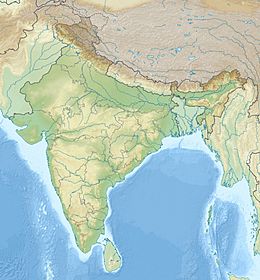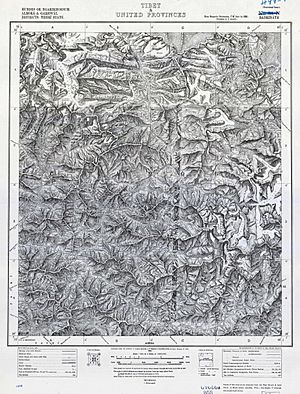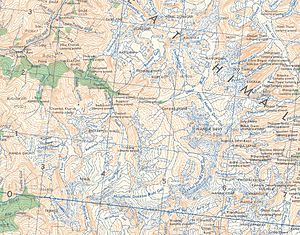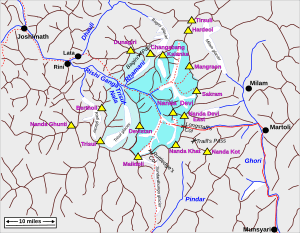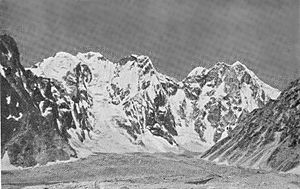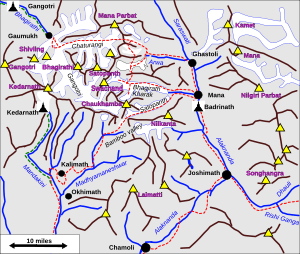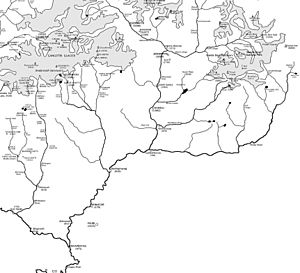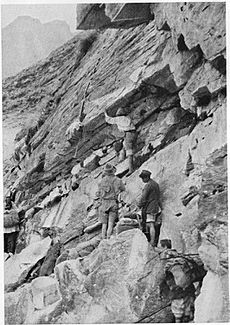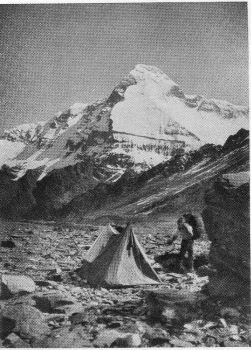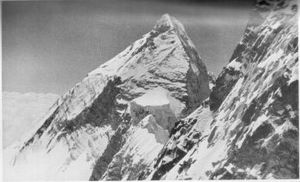Shipton–Tilman Nanda Devi expeditions facts for kids
Quick facts for kids Nanda Devi |
|
|---|---|
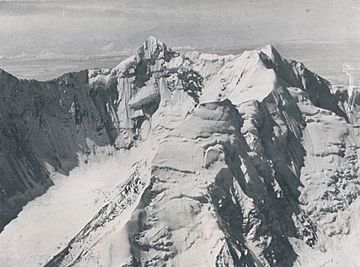
Nanda Devi photographed in 1936
|
|
| Highest point | |
| Elevation | 7,816 m (25,643 ft) |
| Naming | |
| Native name | Error {{native name}}: an IETF language tag as parameter {{{1}}} is required (help) |
| Geography | |
| Location | Chamoli District, Uttarakhand, India |
| Parent range | Garhwal Himalaya |
| Climbing | |
| First ascent | 29 August 1936 by Noel Odell and Bill Tilman |
The Shipton–Tilman Nanda Devi expeditions were amazing adventures that happened in the 1930s. Nanda Devi is a huge mountain in the Himalayas, located in northern India. For a long time, people thought it was the highest mountain in the world!
Nanda Devi is special because it's surrounded by a ring of other mountains. This ring creates a hidden area called the Sanctuary. For many years, no one could find a way inside. But in 1934, two explorers named Eric Shipton and Bill Tilman, along with three skilled Sherpa climbers, finally found a path. They entered the Sanctuary through a difficult river gorge called the Rishi Ganga.
Then, in 1936, Tilman and Noel Odell were part of a team that climbed all the way to the top of Nanda Devi. At 25,643-foot (7,816 m) high, it became the highest mountain ever climbed at that time! It wasn't until 1950 that a higher peak, Annapurna, was successfully climbed. Nanda Devi was climbed for the second time in 1964.
Contents
Exploring the Hidden Sanctuary
Nanda Devi is almost completely surrounded by a ring of mountains. The only way in or out is through the very deep and narrow Rishi Ganga gorge. Many explorers tried to get through this gorge, but none succeeded.
The First Entry in 1934
In 1934, before the rainy season (monsoon), Eric Shipton and Bill Tilman decided to try. They were joined by three Sherpa climbers: Ang Tharkay, Pasang, and Kusang. These Sherpas were considered equal partners in the climb. Together, they became the first people to find a way through the tough gorge and step into the Nanda Devi Sanctuary. This achievement was called "the most exciting story in the whole saga of mountain discovery."
After exploring the Sanctuary, they had to leave because of the monsoon rains. But their adventure wasn't over! They continued exploring other areas. They even crossed a mountain range between Badrinath and Kedarnath for the first time ever. This was a huge feat that wasn't repeated until 1998.
After the monsoon, they returned to the Sanctuary. They climbed part of Nanda Devi's southeast ridge. This helped them discover the best route to the summit, which was used in 1936. They then left the Sanctuary by finding a new way over a mountain pass to the south. People had thought this route was impossible before.
The Historic Climb in 1936
In 1936, Nanda Devi became the highest mountain ever climbed. This was thanks to a joint American and British expedition. Bill Tilman ended up leading the final climb. He had planned for Charlie Houston and Noel Odell to make the summit attempt. However, Houston became ill, so Tilman himself partnered with Odell. Together, they reached the 25,643-foot (7,816 m) summit by climbing the southeast ridge.
Nanda Devi and the Garhwal Region
Mapping the Mountains in the 1800s
At the start of the 1800s, people thought the Andes mountains were the tallest in the world. But then, explorers started measuring peaks in the Himalaya. The Great Trigonometric Survey of India began mapping the Garhwal District in India.
By 1820, the highest mountain measured was Peak XIV in the Garhwal Himalaya. It was called Nanda Devi by the local people. It was the highest known mountain until 1847, when Kanchenjunga was measured. The survey also found that Nanda Devi was surrounded by a ring of very high mountains. They realized this area, not Lake Manasarovar, was the true source of the Ganges River.
Spiritual Importance of the Region
The state of Uttarakhand, where Nanda Devi is located, is very important for both Hinduism and Buddhism. Over time, these two religions have mixed a lot in this area.
The four shrines of Chota Char Dham in Garhwal are very sacred places for Hindu pilgrims. They are located at the sources of the Ganges River. However, the source of the Rishi Ganga river, which flows from Nanda Devi, is too hard to reach.
Nanda Devi is named after the Goddess of Bliss. She is believed to live on top of the mountain. The story says that the Seven Rishis (wise men) were driven to this mountain by demons before they became stars in the sky. Nanda Devi left her mountain to live with her husband, Shiva, on Mount Kailash in Tibet. But once a year, in October, she returns. This is a time of great celebration for pilgrims.
Early Attempts to Explore Nanda Devi
Before 1883, no one had really tried to cross the ring of mountains around Nanda Devi. In that year, William Woodman Graham, a climber who came to the Himalaya just for fun, tried to enter the Nanda Devi Sanctuary. He tried to go up the Rishi Ganga river gorge, but the lowest part was impossible. He found a way to reach the outer part of the Sanctuary, but he couldn't get any further inside.
In 1905, Tom Longstaff and two Italian guides tried to explore Nanda Devi. Longstaff always traveled with a small team, carrying their own gear. They reached a high mountain pass east of Nanda Devi's summit. From there, they could see into the Sanctuary, but they couldn't climb down into it. The Sanctuary is a huge area, about 250 square miles (650 km2), completely surrounded by mountains over 18,000 feet (5,500 m) high. The Rishi Ganga gorge was the only way in, and it was too difficult. This hidden Sanctuary became a place of great interest for explorers.
Two years later, Longstaff's team, joined by Charles Granville Bruce, successfully climbed Trisul, a mountain southwest of the Sanctuary. This was the highest peak climbed for 23 years.
Eric Shipton's first visit to the Himalaya was in 1931. He was part of an expedition that made the first climb of Kamet. Shipton was in the group that reached the highest point ever achieved at that time. Later, he explored the mountains around Badrinath. He loved the beautiful flowers and amazing scenery there.
After a big expedition to Mount Everest in 1933, Shipton realized that small expeditions could be more fun and even more successful. Inspired by Longstaff and the unexplored Rishi Ganga gorge, Shipton decided to plan his own trip to the region.
Shipton and Tilman: A Climbing Team
Bill Tilman was born in 1898. He was a brave soldier in World War I, even earning medals for his courage. After the war, he moved to Africa and became a successful coffee farmer.
Eric Shipton was nine years younger. He grew up in Sri Lanka and loved mountaineering. He moved to Africa to work on a coffee farm, which was close to Mount Kenya. There, he improved his climbing skills. Tilman heard about Shipton's climbing and wrote to him for advice. This is how their climbing partnership began. In 1930, even though Tilman was new to climbing, they successfully climbed Mount Kenya's west ridge for the first time.
Back in Britain, Shipton planned to explore the Garhwal region again. He wanted to explore the mountains between the important Hindu shrines of Badrinath, Kedernath, and Gangotri. But Longstaff encouraged him to try and enter the Nanda Devi Sanctuary instead.
Shipton invited Tilman to join him on a seven-month expedition to the Himalaya. Tilman, who had just cycled across Africa, immediately accepted! Shipton later wrote that if they hadn't met at the right time, their lives would have been very different.
Shipton was friendly and outgoing, while Tilman was quiet and preferred to be alone. But both men were incredibly strong and dependable. They became the perfect climbing partners because they could always rely on each other.
The 1934 Expedition: Into the Sanctuary
By 1934, even though climbers had gotten close to the top of Mount Everest, no one had even reached the base of Nanda Devi. This was surprising because Nanda Devi was the highest mountain in the British Empire at the time.
Getting Ready and Traveling
Shipton asked Karma Paul, an experienced Sherpa, to hire three Sherpas for the trip. He chose Ang Tharkay, Pasang Bhotia, and Kusang Namgir. They had all been on the 1933 Everest expedition. The team packed simple supplies and planned to eat like the Sherpas, mostly chapatis, rice, and tsampa.
On April 6, 1934, Shipton and Tilman sailed from Liverpool to Kolkata. They met the Sherpas there, and the five men traveled by train and lorry to Ranikhet. They hired porters, bought food, and then trekked for ten days to Joshimath. From there, their exploration towards the Sanctuary began.
Climbing Through the Rishi Ganga Gorge
They followed a route discovered by William Graham, going along the Dhauliganga River. They passed the Rishi Ganga gorge and climbed the Lata hills. This allowed them to reach a survey station, which they used to help with their own mapping.
They hiked through high grazing areas and then descended to the middle of the Rishi Ganga gorge. This is where they set up their base camp and sent the porters back. At this point, the gorge is like a narrow box canyon, with walls rising 10,000 feet (3,000 m) above the river.
The five men had to carry 250 kg of supplies along dangerous cliffs. Sometimes, they were directly over the river! They accidentally lost a rucksack with most of their lentils, which was a big problem for their food supply. For seven days, they climbed up the gorge, crossing the river many times.
On June 4, they reached a spot where they couldn't go any further on the north side. Tilman and Ang Tharkay bravely explored a steep rock face on the south side. From the north bank, they looked "like ants on a gigantic wall." But by the end of the day, they had found a clear path! They named this spot "Pisgah" because from there, they could see the summit of Nanda Devi. Two days later, on June 6, the team became the first people to enter the Sanctuary. It had taken them nine difficult days to cover just four miles.
Exploring Inside the Sanctuary
The monsoon rains were expected in about three weeks, which would flood the gorge and trap them. So, they knew their time in the Sanctuary would be short. They explored the northern part of the Sanctuary first. They saw the huge, unbroken northern face of Nanda Devi, which rises 9,000 feet (2,700 m). They also climbed to the rim of the mountains on the northeast side, hoping to find another way out.
On June 24, the monsoon arrived, and they had to leave quickly. They descended the gorge in heavy rain. Shipton later wrote about the Sanctuary: "There was a tremendous variety of birds and any amount of game – most of which can never have seen a man, and stared at us incredibly. I was glad we did not have guns – it would have been a crime to shoot them. It was perhaps the most wonderful three weeks of my life, and I shall never forget a moment of it..."
Crossing Mountain Ranges
Back in Joshimath, they knew the gorge would be closed for a while. So, they decided to try crossing from Badrinath to Gaumukh. This area is very mountainous, and the watershed (the line separating river systems) had never been crossed before. They hired porters and set off on July 12. They explored glaciers and climbed a 21,500-foot (6,600 m) peak. They found a way over the watershed and descended to the Gangotri Glacier.
There was a legend about a high priest who could hold services at both the Badrinath and Kedarnath temples on the same day. People believed he took a shortcut over the mountains, a distance of less than three miles, instead of the long hundred-mile journey. Shipton and Tilman wanted to explore this shortcut.
On August 4, they set off up the Satopanth Glacier. It was a difficult climb over ice and through crevasses. They finally saw that they were at the head of the Kedarnath valley. They faced a huge ice cliff. Shipton and Tilman thought they might have to turn back, but the Sherpas were determined. Ang Tharkay found a very difficult but successful route down. What they thought would be a two-day trip turned into a week-long journey through cliffs, thick jungle, and difficult rivers. They eventually reached villages where they could get food.
Returning to the Sanctuary
On August 30, they left Joshimath again, this time with local porters. Thirteen porters were so excited that they joined the team all the way into the Sanctuary! Shipton was very impressed with their climbing skills.
This time, the team explored the southern part of the Sanctuary. They were looking for a way out over the mountain rim to avoid going through the difficult gorge a fourth time.
Shipton wrote about the Sanctuary: "It would be difficult to give an adequate description of the loveliness of the country in which we found ourselves. Beauty of the wild, riotous kind such as one usually finds in high mountain regions we had expected; but we found, as well, luxuriant pasture, brilliant with wild flowers, and lakes, on whose deep blue and green surfaces was reflected the crusts of icy peaks; birds of great variety and brilliant colours, and large herds of thar and bharal, which were so tame and regarded these strange new visitors with such curiosity, that I was almost glad we had not brought a rifle."
They found a mountain pass that Hugh Ruttledge had spotted in 1932. While Tilman continued mapping, Shipton and the other two made the first climb of Trisul East (now called Maiktoli, 22,320 feet (6,800 m)). The conditions were very tough, "almost up to Everest standards."
Shipton and Tilman then explored a ridge on Nanda Devi itself. They realized this ridge would be a good way to reach the summit for a future expedition. On September 17, the whole team started climbing to Ruttledge's pass. They looked down a 6,000 feet (1,800 m) cliff and icefall. It took two days to find a route down, and Ang Tharkay was the one who finally found the successful path. They descended the valley and eventually reached a bus that took them back to civilization.
Mount Everest and the 1936 Expedition
After Shipton's presentation about Nanda Devi in 1935, everyone was very excited. The entire expedition had only cost £287! However, there was no immediate support for another Nanda Devi trip. This was because Tibet had given permission for attempts on Mount Everest in 1935 and 1936. So, Shipton and Tilman were chosen to lead a reconnaissance (scouting) expedition to Everest in 1935. This trip was very successful.
The British–American Himalayan Expedition, 1936
Four American students from the Harvard Mountaineering Club decided to plan a lightweight expedition to the Himalaya. They wanted to climb Kanchenjunga, which was the third-highest mountain in the world and had never been climbed. They invited experienced British climbers to join them. Thomas Graham Brown accepted, and he invited Shipton (who was busy with Everest) and Tilman (who accepted). Noel Odell and Peter Lloyd also joined.
The Americans were advised that Nanda Devi might be an easier goal than Kanchenjunga. So, they changed the expedition's name to the "British–American Himalayan Expedition." Later, Charlie Houston wrote, "It's hard to believe how naïve and presumptuous we were... Four American college kids... inviting the best British climbers on a major climb in the Himalayas." But the Americans were actually very skilled climbers.
Tilman went ahead to India. After being denied permission for Kanchenjunga, he prepared for Nanda Devi instead. He hired Sherpas, including Pasang Kikuli and Pasang Phuta. By June 16, 1936, they had carried 900 pounds (410 kg) of supplies beyond Pisgah in the gorge. A few days later, the whole team met up and set off for the Sanctuary.
They faced problems when the porters refused to go past a certain point, and all the Sherpas became ill. One Sherpa, Kitar, sadly died three weeks later. So, the European climbers had to carry the supplies themselves through the Sanctuary and up the mountain.
Climbing Nanda Devi's Summit
They set up a camp called Moraine Camp at 15,000 feet (4,600 m) at the base of Nanda Devi. They used juniper wood for fuel to save their paraffin for the actual climb. Everyone was in good spirits.
Their main base camp was set up on a rocky slope leading to the mountain's south ridge. They had enough food and fuel for at least three weeks. Camp one was at 19,200 feet (5,900 m), but they had to dig out four small platforms in the deep snow to set up tents. Tilman was very impressed with how well everyone was getting used to the high altitude. Despite heavy snowfall, they established Camp Two at 20,400 feet (6,200 m) and Camp Three at 21,400 feet (6,500 m).
Moving people and supplies between the small camps became very difficult. So, they decided to vote for a leader. Tilman was chosen. After delays from a snowstorm, he picked Houston and Odell for the summit team. They climbed to 23,400 feet (7,100 m) and set up a temporary camp.
The next day, Houston and Odell climbed strongly, but they realized they couldn't reach the summit that day. They returned to their camp. Houston then ate some bad meat and became too ill to continue. Odell called down the mountain, "Charlie is ill!" But the American climber Carter misheard him as "Charlie is killed" because of Odell's accent. A very sad group set off to retrieve the "body," with Tilman being the only one who brought all his climbing gear. When they arrived, they were greeted by a cheerful Odell!
Houston insisted on going down so someone else could take his place. Since Tilman was the only one fully equipped, he joined Odell. They moved their tent up to a higher camp at 24,000 feet (7,300 m). On August 29, 1936, in eight hours, they climbed to the summit in cold, clear weather. They had reached the top of the highest mountain ever climbed – 25,643 feet (7,816 m)! Tilman, who was a very private person, joked, "I believe we so far forgot ourselves as to shake hands on it."
Most of the team went back down the gorge. But Tilman, Houston, and Pasang Kikuli took on an extra challenge. They crossed Longstaff's 1905 mountain pass and descended into another valley, eventually reaching Ranikhet.
Tilman later wrote about reaching the summit: "I remember, in the small hours when the spark of life burns lowest, the feeling which predominated over all was one of remorse at the fall of a giant. It is the same sort of contrition that one feels at the shooting of an elephant."
The Osmaston–Shipton Expedition, 1936
Gordon Osmaston, a director of India's survey team, knew about Shipton's 1934 explorations. He planned to improve the maps of the Sanctuary using special equipment. As he was leaving Darjeeling, he met Shipton, who was returning from the 1936 Everest expedition. Shipton immediately agreed to join Osmaston's team, hoping to meet up with Tilman's Nanda Devi climbers. Ang Tharkay and Tenzing Norgay also joined as Sherpas.
They met Peter Lloyd, who was coming down the Rishi Ganga gorge ahead of the main climbing party. This is how they learned that Nanda Devi had just been climbed! Shipton wrote to a friend, "What a glorious effort of Bill and Odell to have climbed Nanda Devi. I am overjoyed that it was Bill who did the touchdown – he so thoroughly deserves every inch of his success [...] I confess I wished I had been with them instead of wasting time on that ridiculous Everest business." He also said, "By Jove, it will shake the old fools at home," referring to the Everest Committee who had doubted the expedition.
Osmaston mapped the northern glacier of the Sanctuary, while Shipton explored the Changabang glacier. Shipton then went down the Rishi Ganga gorge, tried to climb Dunagiri (but failed), and crossed another mountain pass. He returned to Joshimath and continued surveying other glaciers and mountain saddles.
What Happened Next
It wasn't until 1950 that a higher mountain than Nanda Devi was climbed. On the French Annapurna expedition, Maurice Herzog and Louis Lachenal climbed Annapurna I, which is 26,545 feet (8,091 m) high. This was the first 8,000-meter peak ever climbed. Ang Tharkay was the lead Sherpa on that expedition.
Nanda Devi's main peak was climbed for the second time in 1964. The difficult Badrinath–Kedarnath watershed, which Shipton and Tilman crossed in 1934, was crossed for only the second time in 1998. One of the people in that group was John Shipton, Eric Shipton's son!


